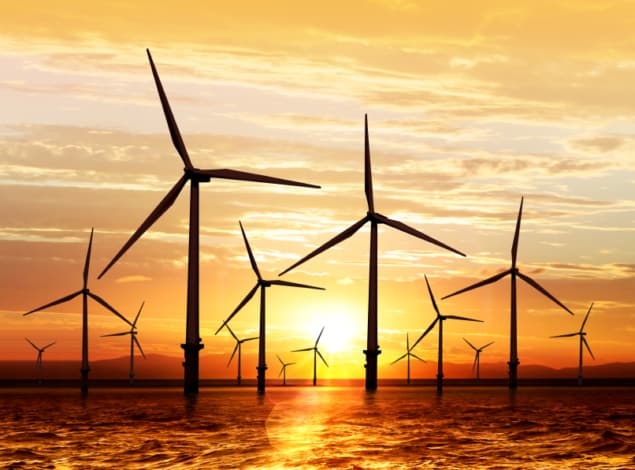
Optimizing the placement of turbines within a wind farm can significantly increase energy extraction – but only until the installation reaches a certain size, researchers in the US conclude. This is just one finding of a computational study on wind turbines’ effects on the airflow around them, and consequently the ability of nearby turbines – and even nearby wind farms – to extract energy from that airflow.
Wind power could supply supply more than a third of global energy by 2050, so the researchers hope their analysis will assist in better designs of wind farms.
It is well known that the efficiencies of turbines in a wind farm can be significantly lower than that of a single turbine on its own. While small wind farms can achieve a power density of over 10 W/m2, this can drop to a little as 1 W/m2 in very large installations The first law of thermodynamics dictates that turbines must reduce the energy of the wind that has passed through them. However, turbines also inject turbulence into the flow, which can make it more difficult for downstream turbines to extract energy.
“People were already aware of these issues,” says Enrico Antonini of the Carnegie Institution for Science in California, “but no one had ever defined what controls these numbers.”
Fluid dynamics
In the new research Antonini and colleague Ken Caldeira used fluid dynamic models to examine the airflow over turbines. They considered multiple, idealized simulations of both small and large wind farms.
First, they looked at the individual wakes of each turbine, studying different arrangements. Reducing the turbine density in small wind farms provided a higher output per turbine, they found, but they also found that arranging the turbines in rows facing the wind or in a mosaic pattern provided a 56% greater power output than arranging them in wind-facing columns. “Gains in energy generation can be 10, 20, even 30% if you have an optimal arrangement of turbines with respect to a random arrangement as you can reduce this wake interaction between the turbines,” says Antonini.
These gains largely vanished, however, as wind farms grew very large. To find out why, the duo used meteorological simulations of wind speed. They found that, whereas in a small wind farm the principal cause of loss of output of a wind turbine is the wake of its near-neighbours, which can be mitigated by careful design, in a large wind farm the surface wind speed is slowed down by the greater drag of that region.
Uniform wake
“For large wind farms, there is a limit on how much energy can be replenished on the order of 1 W/m2,” says Antonini. “[The turbines] create a kind of uniform wake across the wind farm.” The wakes of these large farms could extend tens of kilometres downstream, potentially affecting other wind farms.
The transition between a wind farm in which turbine arrangement was significant factor and one in which it was not occurred after a farm reached about 30 km in size. There was no clear dividing line between the two regimes, however, and several factors such as the wind speed in the upper atmosphere and, curiously, the latitude of the wind farm affecting the calculations. Wind farms closer to the equator were, in general, able to grow larger before efficiency tailed off to a minimum because the Coriolis effect caused by the rotation of the Earth relative to the wind farm replenished the energy and momentum of the wind in the wake.

Flying the flag for wind energy
“That was something no one was aware of, to my understanding,” says Antonini. The researchers are developing this concept further to help energy system planners build better wind farms for the future, says Antonini.
Charles Meneveau of Johns Hopkins University in Maryland welcomes the research. “In 2010, we wrote several papers on that infinite wind farm regime, and we did some simulations using different techniques,” he says; “We had an inkling there was going to be an important limit to consider, but at that time that idea was very controversial. This [research] takes that more seriously and puts that in a computational modelling tool that is well established and has been well tested, and really does the work of simulating those length scales.” He concludes that “we’re talking about building such large installations with such a change in our infrastructure that, considering the scale of the stuff, this is really important.”
The research is described in Proceedings of the National Academy of Sciences.



